Four countries, including UK, account for more than half of the EU’s cereals production. France and Germany, among EU’s top producers in agriculture
In the European Union, France, Germany, Poland and the United Kingdom account for 55 per cent of the EU’s cereals production.
A recent report released by the European Statistics Office (Eurostat) reveals that EU’s harvested production of cereals rose in 2015 by 6.3% and oilseeds’ production increased by 9.6% than the previous 8-year average level. On the other hand, during the same period, the production of potatoes decreased by 10.3% while the sugar beet drop by 11.4 per cent.
EU’s largest cereal, sugar beet and oilseed producers in 2015 were by far France and Germany, together accounting 55.1 per cent of the EU-28’s sugar beet production, 37.3% of oilseed production, 45.1% of green maize production and 38.4% of cereal production.
The highest production volume of potatoes, 19.5% of the total EU countries, was registered in Germany, while the United Kingdom, Poland, the Netherlands and France each accounted for between 10% and 14%. Also, France, the United Kingdom and Poland were the main producers of the total EU-28 of dry pulses, registering almost a half (49.9%) of the production.
EU arable area, dominated by cereals
At the level of the entire European Union, the Utilised Agricultural Area (UAA) covered nearly 179 million hectares in 2015. The largest part, 59.8%, was represented by arable land, almost one third was occupied by permanent grassland, and 6.6% by permanent crops.
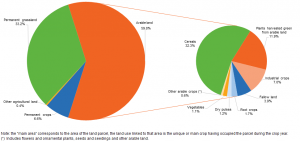
Cereals, including rice, were, in 2015, the main crops cultivated on the total of 107 million hectares of arable land available in the EU-28. These crops covered around 57 million hectares.
“Cereals together with plants harvested green (11.9% of the UAA), industrial crops (7.0%) and fallow land (3.9%) covered 92.3% of the total arable land. The remaining area was dedicated to the growing of root crops (1.7% of the UAA), dry pulses (1.2%), vegetables (1.1%), and other arable crops (0.6%)”, Eurostat’s report reads.
The countries with almost the entire utilized agricultural area are the Nordic Member States, respectively Finland, with 98.6%, Denmark with 89.2 per cent, and Sweden, with 85 per cent. On the other side, the proportion of arable land in total utilized agricultural area in 2015 was less than a half in six Member States:
- Austria – 49.5%
- Luxembourg – 47.9%
- Slovenia – 35.9%
- the United Kingdom – 33.6%
- Portugal – 30.2%
- Ireland – 10.2%.
These six countries registered the highest shares, up to 50% of the total UAA or more, of permanent grassland, “explained by pedologic and climatic factors and high numbers of grazing animals”, Ireland having the highest proportion of grassland, 89.7% of the total UAA.
As for permanent crops, the highest shares of the total UAA were recorded in Greece (24.9%), Cyprus (20.8%), Portugal (20.3%), Spain (19.8%) and Italy (19.3%).
“These high proportions are linked to suitable climatic conditions for growing permanent crops such as olive trees, vineyards and fruit trees”, Eurostat report explains.
How many cereals EU produces
In 2015, the harvested cereal production reached almost 317 million tonnes, of which 152 million tonnes was common wheat and spelt. The second largest harvested quantity, 62 million tonnes or 19.5% of total cereal production, was for barley, followed by grain maize and corn-cob-mix which accounted 59 million tonnes or 18.6% of total cereal production. The other cereals (mostly triticale, rye and oats) registered together a share of 12.9% of total cereals, while EU’s production of rice was less than 1% – around 3 million tonnes – of total cereals production.
Almost half of total EU-28 cereal production was produced by France (22.9%), Germany (15.4%) and Poland (8.8%).
France and Germany were also the largest producers of wheat and barley, accounting together nearly half (44.3%) of total EU-28 wheat and spelt production and 39.8% of total barley production. Spain (10.8%) and the United Kingdom (11.9%) were also other major producers of barley.
Accounting for 23.3% of total grain maize production in the EU, France was also the largest grain maize producer, followed by Romania (15.3%), Italy (12%) and Hungary (11.3%).
As for the rice, only eight countries in the EU produced it “due to challenging growing conditions and climatic prerequisites”. Italy reported almost half (49.8%) of total EU rice production in 2015, followed by Spain with 28.8%.
The production of cereals decreased after the 2014 peak
According to Eurostat’s report, EU farmers reacted with a significant production increase of 21.4%, from 2007 to 2008, “due to comparatively high cereal prices in 2007 caused by unbalanced supply and demand”. Still, bad weather has tangled their plans and led to a production fall in 2009 (– 5.9% compared with 2008). In 2010, the downward trend continued and production dropped again by a further 5.2% than the previous year.
“Although in 2011 cereal production increased slightly (+ 2.4% compared with 2010), a 2.8% drop was registered in 2012. In the next two years the EU cereal production grew, by 8.7% in 2013 and 7.9% in 2014. In 2015 the harvested production was 316.8 million tonnes of cereals, a 4.8% decrease compared with 2014. The 332.6 million tonnes of cereals in 2014 was the highest value recorded in the last 15 years for which data are available for all 28 Member States. Despite the production decreases of 2009, 2010, 2012 and 2015 the total level of cereal production in the EU-28 stood nevertheless 20.3% higher in 2015 than in 2007 (an increase of 53.5 million tonnes),” Eurostat report notes.
Although the harvested area of cereals in the EU-28 remained relatively stable between 2007 and 2015 – never fluctuating by more than 6 %, in the Baltic Member States as well as in Belgium and Bulgaria, in 2015 there was a significant increase in the cultivation area compared to the 2007–14 average for cereals, that ranged from 9.7% in Belgium to 21.2 % in Latvia.
“When comparing the 2015 values with the 2007–14 average, the discrepancy between the increase in harvested production (+ 6.3%) and the area cultivated with cereals (– 1.6%) suggests a significant improvement in yield,” the report points out.
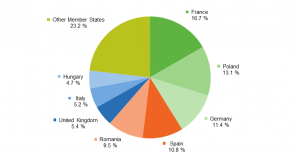
Germany and France, in the top of potato and sugar beet producers
The largest area of root crops (1.7 million hectares) was occupied in 2015 by potatoes, closely followed by sugar beet (1.4 million hectares). The total production of sugar beet in the EU was in 2015 almost 102 million tonnes, after which in 2014, the EU was the world’s leading producer of sugar beet (48.5% of world’s total production).
Share of area under sugar beet by main EU Member States, 2015
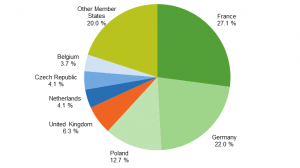
The Member States responsible for more than half of EU-28 sugar beet production were France (32.9%) and Germany (22.2%). Poland (9.2% of total EU-28 production) and the United Kingdom (6.1 %) were also other important sugar beet producers in 2015.
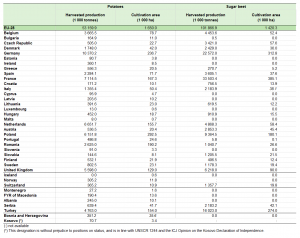
Both potato production and the area under cultivation decreased between 2007 and 2015. Thus, the total harvested area dropped by 0.6 million hectares (– 25.4%), while production fell by 10.6 million tonnes (– 10.3% reduction in relation to the 2007–14 average production) in the same time span.
The largest impact on the overall production decline at EU-28 level was determined by a single large producer, Poland, which accounted 2.9 million tonnes less than the 2007–14 average (– 31.8%).
The potato production was the highest in Germany, (19.5 % of the EU’s total in 2015), and France (13.4%). Together with three other Member States, the Netherlands (12.5%), Poland (11.6%) and the United Kingdom (10.5%), these five countries produced more than two-thirds of total EU’s potato production. Poland had the largest harvested area in 2015 with nearly 0.3 million hectares (17.7% of the EU total potato area), followed by Germany and Romania, each harvesting around 0.2 million hectares.
However, in terms of surface production, the highest, 46.5 tonnes per hectare, was registered in Belgium, followed by Germany, with 43.8 tonnes/ ha, and UK – 43.3 tonnes per hectare.
The decline of sugar beet
Between 2007 and 2015, EU’s sugar beet production area was reduced by 28.4%. Despite of this area reduction, the production decreased by only 11.4 per cent.
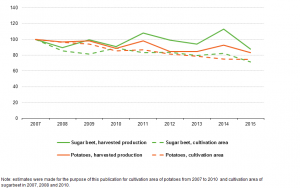
In some Member States sugar beet production declined between 2015 and the 2007–14 average, as follows:
- Portugal (– 89.7 %)
- Bulgaria (– 73.7 %)
- Greece (– 64.8 %)
- Sweden (– 48.1 %)
- Croatia (– 38.5 %)
- Italy (– 37.3 %).
Instead, the sugar beet production volumes increased the most in Romania (+ 20.3%), followed by Slovakia (+ 18.3%) and Denmark (+ 6.2%).
France, the largest EU producer of dry pulses. UK is also in top
The production of dry pulses, such as field peas, broad and field beans, sweet lupins, dry beans, chick peas, lentils or vetches, reached 5.1 million tonnes in the EU-28 in 2015. The harvested production of field peas and broad field beans was 2.1 million and 1.9 million tonnes, respectively.
The largest producer of dry pulses in 2015 in the EU was France, with 18.1% of the EU-28 total, followed by UK (17.9%) and Poland (13.9%).
While UK was the leading producer of broad and field beans in 2015, accounting for 38% of the EU, followed by France (12.9%) and Lithuania (9.9%), the production of field peas accounted for nearly a third (31.9%) of total EU production in 2015 in France, followed by Germany (13.3%) and Lithuania (11%).
Oilseed production across the EU
Main oilseeds – which are essentially used to provide vegetable oil for the food industry and in producing biodiesel – such as rape and turnip rape, sunflower seed and soybeans, were grown on 11.6 million hectares across the EU Member States in 2015.
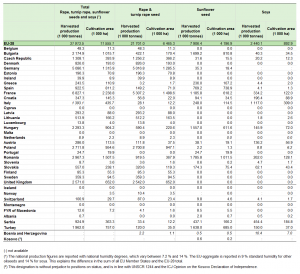
The largest main oilseed producer was by far France, which accounted over one fifth of the EU total production and 19.4% of the total EU harvested area of oilseed., followed by Germany, with a share of 15.9%, Romania with 9.3% and Poland with a share of 8.5%.
As for rape and turnip rape, out of a total of 21.7 million tonnes harvested in 2015 (68% of the total oilseed production), the largest producer was France, with 24.5% of the total production. In the top were also Germany (23.1% share), Poland (12.4%) and UK (11.7%).
On the other hand, sunflower seed production is concentrated in Eastern and Southern Europe, Romania being the largest producer, with 22.6% of the production in 2015, followed closely by Bulgaria (with 21.5%), Hungary (19.7%) and France (15%).
The production of oilseed crops on the rise
Due to the mandatory use of biofuels in the EU by 2020, the harvested production of main oilseed has grown substantially from 2007 to 2015, in the intra-Community space, respectively by 31.7%. The EU-28 main oilseed production in 2015 was almost 32 million tonnes, 9.6% higher than the 2007–2014 average. The growth rate of production was higher than the increase of the cultivation area.
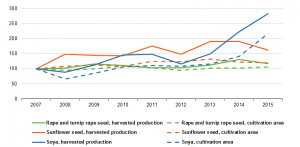
From 2007 to 2015, the production of soya increased by 183.2%, while the yield in 2015 grew with 108.9 per cent than the 2007–14 average. Among the countries with the largest increases both in harvested tonnes and in cultivated hectares of soya were Italy, France, Croatia and Hungary.
The production of sunflower seed increased by 62.2% since 2007, reaching 7.9 million tonnes in 2015, while rape and turnip rape seed had during the same time span with an increase of 17.2% (3.2 million tonnes) of the harvested production.